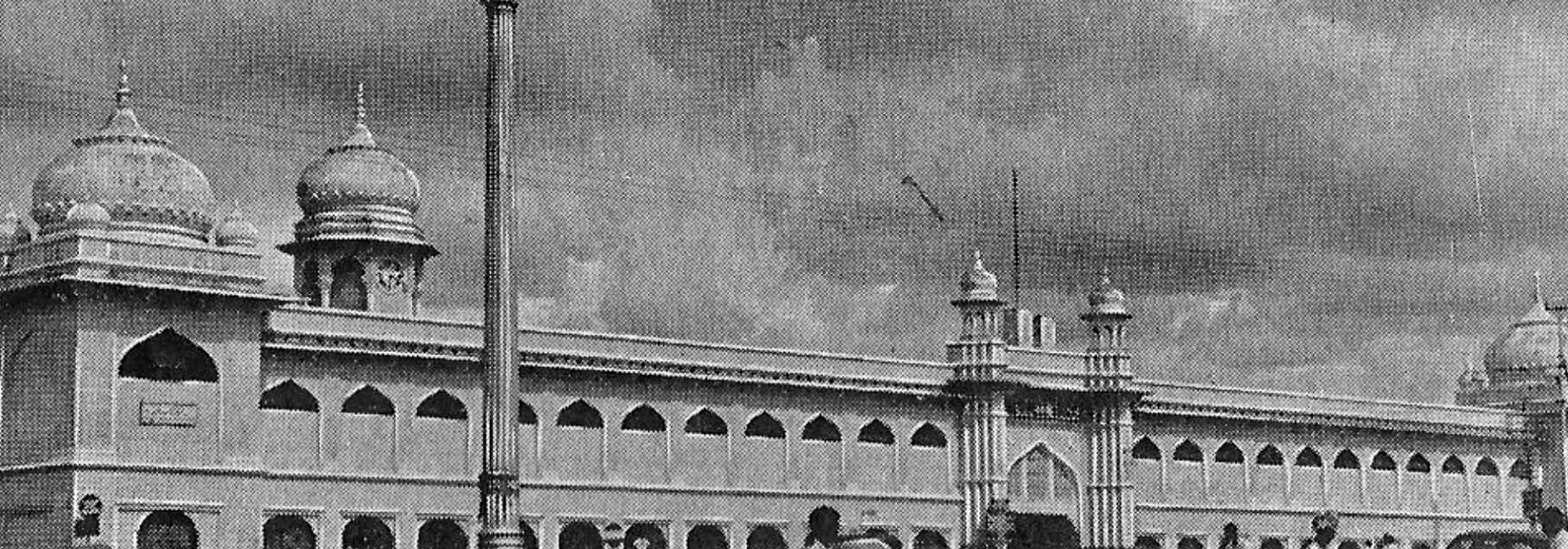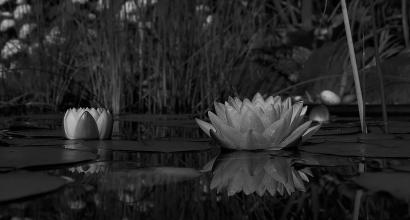I mentioned earlier that as per the recommendation of my friends, M G Varadacharya was the third of the three people in Bangalore who were best suited to estimate the worth of English poetry.
Around thirty-four years have elapsed since Varadacharya left us all (c. 1918-19). Even so, every time I remember his name, my throat is choked, my breath becomes heavy, and eyes become moist. He was such was an intensely emotional[1] character.
When I went to his house the first time, he was preparing for the BL (Bachelor of Law) exam a second time, having failed in his first attempt. He lived in the last house located in the southern direction on the eastern row of Appajappa’s Agrahara in Chamarajpet. The place has changed completely now. When I went to his place, he was wearing a red silk dhoti.[2] Of another cloth made of the same material, one half he wore as a headgear and the other half as a shawl. I was a bit surprised seeing him in this attire at three in the afternoon.[3] I hazarded a guess – on that particular day, there might have been a delay in lunch. A few days later I realized that my assumption was baseless. On that day too, he had partaken of his regular lunch. But because his mind was occupied with one of his hobbies, he did not see the urgent need to change from his traditional attire used during worship and remained as he was.
When Varadacharya saw me coming, he came from within the house with a bright smile on his face, reached the front entrance, took me inside, and made me sit down in the central part of the house. All four surrounding walls were adorned with lovely paintings and photographs. In the middle of the room, on a table I saw framed photographs of Ramakrishna Paramahamsa and Swami Vivekananda placed on a pedestal covered in silk cloth and decorated with garlands of flowers. This sight attracted my eyes at once, and over and over again. Immediately I gained confidence from the fact that he and I were both worshippers at the same temple.
I introduced myself and explained to him the purpose of my visit. He told me with a smile, “I too am one who would commit such offences,” and expressed his desire to examine the papers in my hand. By then, my poem had already been polished at the hands of Krishnaswami Iyer. I did not see anything that could obstruct the flow of Varadacharya’s reading. With a constant smile, he read it from beginning to end and said, “Bhesh!”[4] He said, “I too wanted to write four lines welcoming Swami Abhedananda-ji. Whatever sentiments I had put aside for that purpose, you have already brought it here!” This is the sign of his magnanimity. I remember even now that he himself had written four beautiful verses (on Abhedananda) and they were composed in his own distinct style.
In those days, the Ramakrishna Math was in the first building in the southern side of the eastern row of Appajappa’s Agrahara in Chamarajpet. Swami Atamananda, a serene and elderly monk used to head the maṭha. Varadacharya would unfailingly pay a visit once a day. He and I often met there and chatted. Atmananda-ji had a special affection for him. By then, Varadacharya had gained admiration from many people. He was still a student at that time and yet elders would show him great respect.
That Varadacharya versified beautifully in English was well-known in Bangalore’s learned circles[5] of the day. Sometime during 1908-09, he published a series of verses titled ‘Lal-Bal-Pal’ to oppose the unjust punishment imposed by the British Government on the brave Indians Lala Lajpat Rai, Bal Gangadhar Tilak, and Bipin Chandra Pal. Many used to recite these verses having learnt it by heart. I have read many of his other English verses. I have published his poems reminiscing Gopal Krishna Gokhale. I’ve seen many of his excellent verses caught in his notebook waiting for publication. His family and friends had a plan for some time to publish a small collection of poems including both the published ones and those still in manuscript form. One can cite many reasons for this plan not materializing; but there’s no use in that. The world has lost many beautiful things; Varadacharya’s English poetry anthology too is one among them.
M G Varadacharya basically hailed from Srirangapatna. His grandfather, Kavi Varadacharya was a great scholar in the court of Mysore kings. His maternal uncle, Dr. B Ramaswamy Iyengar who founded the first Eye Hospital in Bangalore [in 1896]. His elder sister Smt. Srirangamma was the first among women in Mysore State who earned a BA (Bachelor of Arts) degree. She won many accolades in the education department and now by the grace of the almighty she lives in Malleswaram as an eminent person.
M G Varadacharya was fond of get-togethers with like-minded people.[6] Varadacharya would participate in the assembly of friends that used to gather at Dr. Ramaswamy Iyengar’s residence almost every evening. Iyengar’s wife and a female relative hailed from Bengal and they belonged to the Brahmo Samaj. In those gatherings, ideas from various philosophical schools, literary topics, the philosophy of art and painting, social issues, and all public matters were discussed. Varadacharya took part in those discussions and was known as a good orator in the group.
After Varadacharya earned his BL degree and began practicing law, he did not get sufficient time to attend those friendly gatherings in his maternal uncle’s house. Soon the responsibilities of his profession started growing.
Varadacharya began his law practice in the chambers of the already well-known advocate L Srinivasa Iyengar. Only a few years prior to that, C S Doraiswami Iyer too joined the same office. Almost everyone will remember that Doraiswami Iyer finally became the Chief Justice of Mysore High Court. Sometime around 1914-15 Doraiswami Iyer and Varadacharya together started an independent office. From then onwards, their income and success grew rapidly day by day. One could easily guess that Varadacharya would have reached the position of a High Court Judge had he lived long enough and none who knew him would dismiss this as wishful thinking; at least one could say that he would have reached the pinnacle of public life and taken the highest ranked positions reachable by a citizen. By 1917-18, Varadacharya’s law practice was one among the four or five successful practices in Bangalore, with monthly earnings in thousands of rupees.
The discussion about Varadacharya’s profession has crept in only incidentally. What I wanted to tell about him is neither concerning his mastery in law nor his income. Varadacharya’s traits of literary connoisseurship[7] and interest in public welfare endeared me to him.
Varadacharya was a persuasive orator. His body language and his facial expressions were particularly suited for revealing many special human emotions. His tone of voice was affectionate and dignified. A thin line of humour always used to play around his lips. His brilliant eyes shone in accordance with the emotions of the situation under narration. And words would be flowing fluently. It was so natural for him to choose and arrange a line of words magnificently, which at first would fill the ears of the listeners and then pervade through their minds with its subtle suggestions. Whether it was in a serious lecture on stage or a casual chat with his friends in a party, the beauty of the sentence, the touch of humour, or the authority on the topic was the same all throughout.
To be continued...
This is the first part of a three-part English translation of the third chapter of D V Gundappa’s Jnapakachitrashaale (Volume 1) – Sahiti Sajjana Sarvajanikaru. DVG wrote this series in the early 1950s. Thanks to Śatāvadhāni Dr. R Ganesh for his review. Edited by Hari Ravikumar.
Footnotes
[1] The original has ‘rasapūrṇa,’ literally ‘filled with rasa (aesthetic enjoyment, art experience).’
[2] Called ‘maguṭa’ or ‘kacce’ in Kannada, this is typically worn during the performance of pūjā (worship).
[3] Typically, the pūjā is completed before lunch and then the attire changes.
[4] A word used for appreciating someone or something; akin to the English ‘bravo!’
[5] The original has ‘vidvadgoṣṭhi;’ ‘vidvat’ refers to ‘scholarship,’ ‘goṣṭhi’ means ‘assembly,’ ‘society,’ or ‘fellowship.’
[6] The original has ‘sneha-goṣṭhi,’ which means ‘an assembly of friends.’
[7] The original has ‘sāhityarasikate;’ ‘sāhitya’ means ‘literature’ and ‘rasikatā’ refers to the trait of cultivating a fine sense of rasa (aesthetic enjoyment, art experience).











































